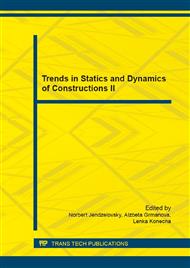p.109
p.113
p.121
p.127
p.131
p.135
p.140
p.146
p.152
Impact of Works Parameters on Resistance of Fasteners
Abstract:
Each structure should be designed so that the entire intended lifetime fulfilles its objectives in terms of usability, resistance and stability without significantly lowering its usefulness and without excessive, unpredictable maintenance costs. Therefore, each time selecting the appropriate fastener at the design stage of the load it must be determined how it can act on it during operation. Typically, the calculation takes into account the normal conditions. In reality, however, the fastener can operate in abnormal conditions. Effects of operating temperature and humidity onto a load-bearing capacity of fasteners of various types have been determined by the work. The study was conducted for concrete with different strength.
Info:
Periodical:
Pages:
131-134
Citation:
Online since:
June 2016
Authors:
Price:
Сopyright:
© 2016 Trans Tech Publications Ltd. All Rights Reserved
Share:
Citation:


